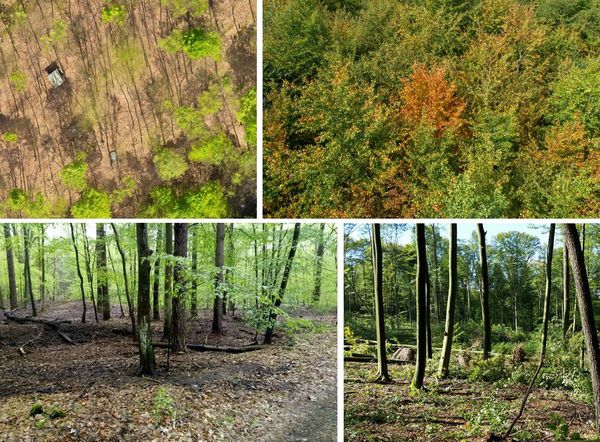Research sites
The experimental site “Britz“ allows us a unique insight into the dynamics of forest ecosystems. Nine large-scale lysimeter and two climate stations provide data on ground water production in forests under different tree species compositions. However, there is much more to discover on the site:
Sap flux measurements supply high resolution data on water usage by the trees. Come visit one of our trees at https://treewatch.net/thunen-institute-forest-ecoystems/ and follow how water transport causes shrinking and swelling of the stem. Here we collect important information on the reaction of trees to changing climate conditions.
Unmanned aerial vehicles allow a view from above. We use it to assess tree crown conditions. This perspective is still rather rare in forest research and offers new insights about individual trees’ varying phases of leaf development and colouring in otherwise homogenous forest stands. This information helps us explain differences in the ability to respond to environmental changes of individual trees and to advance tree growth models.
Production of sufficient quantities of high quality water is an important service provided by forest ecosystems. The amount of newly produced ground water largely depends on the tree species, the age, and the management form. This widely accepted knowledge is based on the results of decades of research at our experimental sites in Britz and Postluch as well as other nearby forest study sites.
Global warming requires an adaption of forest ecosystems to future climate conditions. In our open air drought laboratory and in a greenhouse we study the adaptive capacity of young forest trees. On study sites in forests, we observe the growth and the vitality of older trees and forest stands. The analyses of links between weather impacts and tree response give us insights into the drought tolerance of forests. These results are the basis for management advice for tomorrow’s forestry.
The increase in forest fires is a result of global warming. Forest fire monitoring presents a technical challenge. We rise to it by developing a novel early warning system. To make the system – and other monitoring equipment - energy self-sufficient, we cooperate on technical solutions with scientific and industrial partners. Changing environmental conditions and management practices affect the biodiversity in forests and the landscape. Through specific studies and analyses of forest monitoring data we provide new information on the influence of environmental parameters and evolving management practices on different aspects of biodiversity and analyse the consequences for nature conservation in forests.
Contact

- Phone
- +49 3334 3820 339
- tanja.sanders@thuenen.de
Head of Ecology and Forest Dynamics, Contact person Intensive Forest Monitoring

![[Translate to English:] [Translate to English:]](/media/_processed_/9/2/csm_Allgemein_Thueringen_Hainich_Mischwald_Bolte_2__19d9dab56a.jpg)
![[Translate to English:] [Translate to English:]](/media/_processed_/d/2/csm_100_0001_0013_c05c63e7db.jpg)

![[Translate to English:] [Translate to English:]](/media/_processed_/5/a/csm_IMG_8181_af28e3cde2.jpg)
![[Translate to English:] [Translate to English:]](/media/_processed_/e/6/csm_IMG_20220211_094157_4_2c6612faa0.jpg)
![[Translate to English:] [Translate to English:]](/media/_processed_/3/6/csm_bewaesserung_drylab_3_3bb27fa391.jpg)
![[Translate to English:] Logo des Bundesministerium für Ernährung und Landwirtschaft](/media/allgemein/logos/BMEL_Logo.svg)